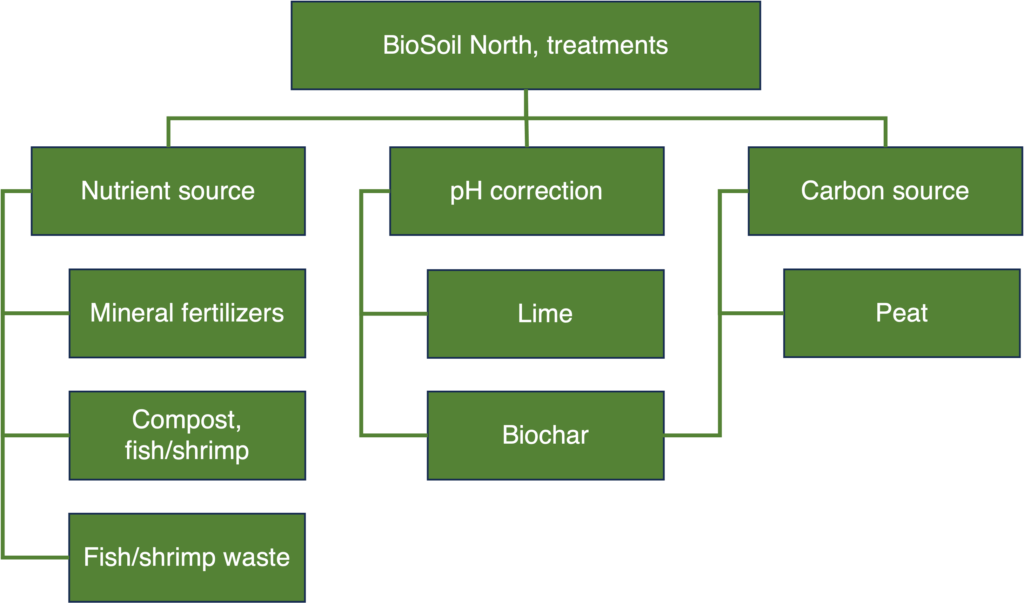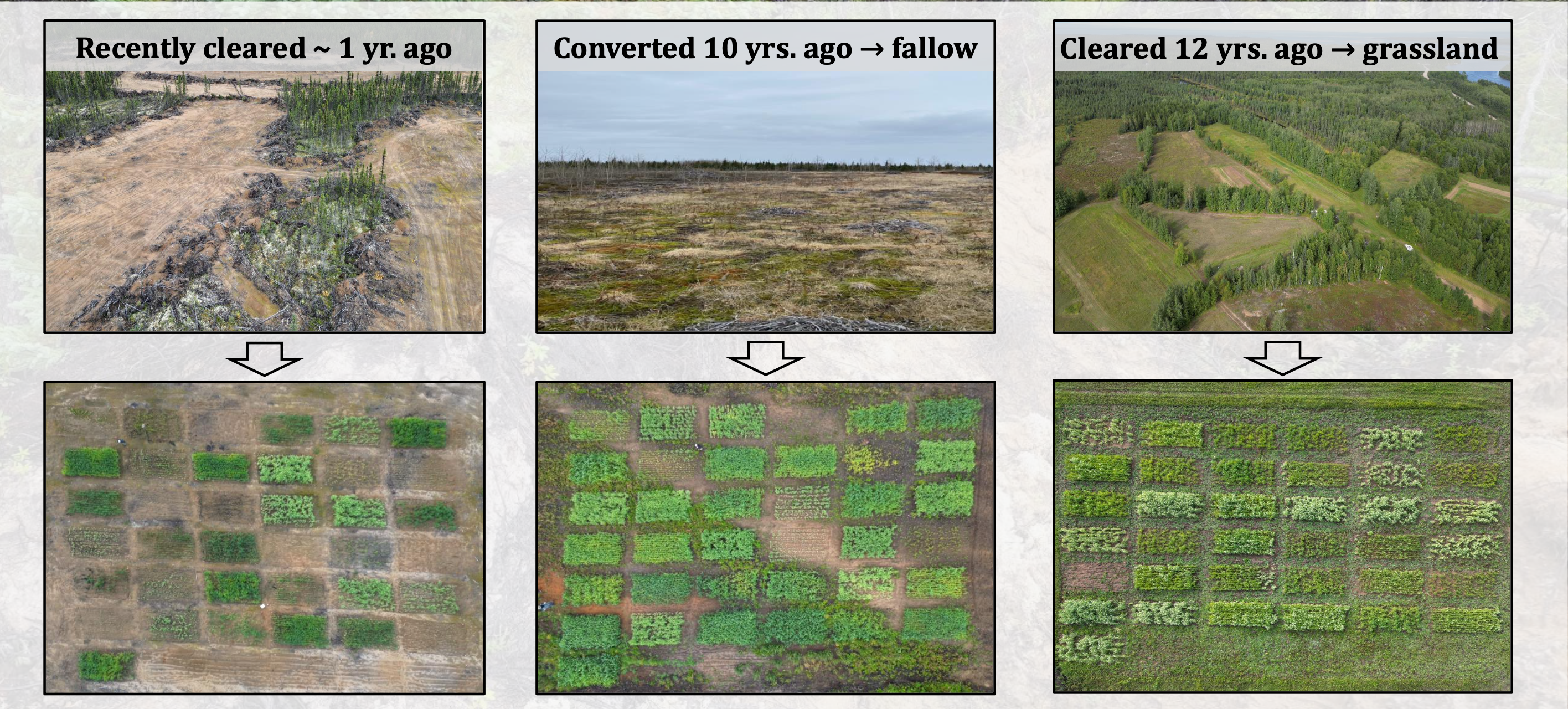In search of food security in the boreal regions of Canada land use conversion (LUC) is used to expand agriculture into boreal forests or natural lands. LUC is strongly supported through regional policies. This disturbs and removes the topsoil rich in organic matter. The resulting farmland is of very low fertility and requires intensive management to increase and maintain its carbon stores and enhance soil health to facilitate sustainable productivity. Organic amendments commonly employed or of interest to the local farmers are of sources that are geographically and seasonally variable in type, quality and quantity. Their stability or mineralization rates, including any priming effects, vary as a function of the soil properties, pre-processing protocols and crop types. Associated greenhouse gasses (GHG) emission profiles are unknown. Preliminary evidence suggests both enhanced sequestration and priming effects. Newfoundland and Labrador is a prime example of dispersed communities with distinct access to organic wastes that are employed to improve soil fertility. We propose to develop an evidence base decision support system that informs on best on-land organic waste utilization practices to facilitate productivity while mitigating GHG emissions. We will compare the utility of locally relevant wastes, the utility of distinct composting options (including classic windrow-type and vermicomposting) for reducing GHG emissions and increasing C sequestration. A whole system analysis approach will be used to identify (a) options for optimization of locally relevant waste streams applied to field or used in greenhouse conditions, (b) GHGs emissions for the differently managed agricultural fields (soil management and cropping system) in selected boreal ecoregions, (c) the relationship between productivity and soil carbon pools in the context of GHG emission potential. The work is carried out on working farms in the boreal regions and involves controlled conditions and field experiments including seasonal considerations. Students and postdoctoral fellows will be trained in agriculture, carbon and GHG sciences, and work with farmers in the local communities, government agricultural agents, and national and international advisers.
The project is a collaboration between the Memorial University of Newfoundland (Prof. Adrian Unc) and University of Waterloo (Prof. Maren Oelbermann), and funded through NSERC-Alliance with contributions from the listed collaborators.
Collaborators
Taiga Valley Farm Inc. (Brian Davis); Nature’s Best Farm (Desmond Sellars); Birch Lane Farm (Jim Purdy and Marge Goudie); NunaKatiget Inuit Community Corporation Inc. (Patricia Kemuksigak); G&M Family Farm Inc. (Gerard Smith); Harbour Main-Chapel’s Cove-Lakeview
Research Sites
Nature’s Best, 53.319379, -60.240156
Birch Lane, 53.318844, -60.213698
Taiga Valley, 53.402786, -60.406076
G&M farm, 47.255970, -53.984974
Harbour Main-Chapel’s Cove-Lakeview, 47.450205, -53.161628
Research activities

Research Team Members
Memorial University of Newfoundland
- Professor Adrian Unc (PI)
- Maxwell Derek Locke (PhD student)
- Sanuja Kalirasa (MSc student)
- Ethan William Garnier (MSc student)
- Amana Jemal Kedir (PDF and PM)
University of Waterloo
- Professor Maren Oelbermann (PI)
- Aman Dhnisa (MSc student)
- Akintayo Afolabi (PhD student)
Research questions
- Does the addition of locally relevant organic fertilizers with variable quality to a sandy Podzolic soil impact the stability of existing and newly formed soil organic carbon, and are these effects detectable below the plough layer? Do these responses differ under contrasting field histories? Particularly, do any of the tested practices favour the formation of stable mineral-associated organic carbon over the more vulnerable particulate organic carbon? (read more here)
- The establishment of endophytes in converted lands: to what extent the natural AMF community might be selected and participate in the AMF community of farmlands post-conversion; to what extent the seed imported AMF’s establish themselves in the new soils; how is AMF selection and establishment faceted by the fertilizer and amendment management
- Impact of the fertilizer management and the conversion status on the nutrient use efficiency and crop productivity. How does the application of specific soil amendments influence the soil’s overall nutrient dynamics? How do these responses differ across different amendments and their combinations? How do interactions between various amendments and plant types influence nutrient dynamics and the activity of the microbial community in the rhizosphere soil, and which combinations are most effective in promoting nutrient budget and plant growth and maximizing crop yield? Impact of different organic waste amendments on the carbon budget after application to soil?
- Fertility, carbon budget and sequestration affected by use of composted and non-composted local organic wastes
- Impact of the conversion history and the tested fertility management options on the GHG budget
- Phosphorus dynamics in the sandy Podzolic soils with the contrasting management history: P adsorption (incubation with and without plant), P availability test using 1% citric acid, Olsen, Mehlich-3, and water extraction techniques and analyzed with ICP-OES; total and organic P quantification.
2023:
Research activities with images to be described here, generally w links to research sites, news etc

2024:
,
2025:
,



